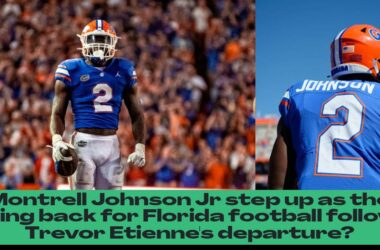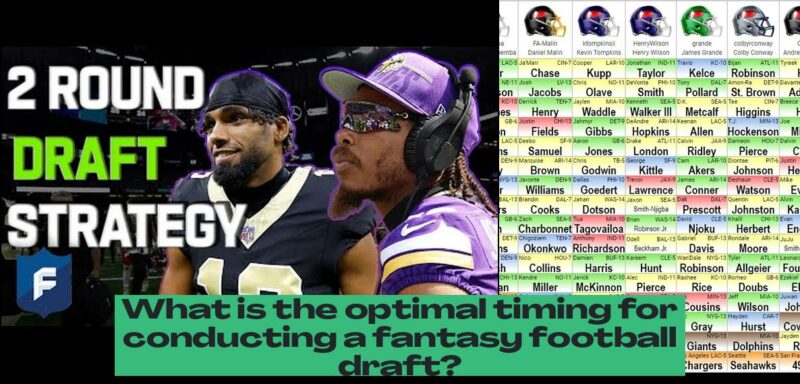When is the Best Time to Hold a Fantasy Football Draft?
The fantasy football draft is arguably the most exciting event of the season. It’s the moment when you assemble your team, armed with hopes and dreams of dominating your league and claiming ultimate bragging rights. But with the NFL season approaching, a crucial question arises: When is the best time to hold your fantasy football draft?
It’s a question that sparks debates amongst fantasy enthusiasts, with strong opinions on both sides. Some swear by drafting early, while others prefer to wait until the last minute to gain a strategic advantage. So, what’s the answer? The truth, as with many things in fantasy football, is nuanced and depends on your individual preferences and league dynamics.
While there’s no one-size-fits-all answer, understanding the pros and cons of different timing options can help you make an informed decision. Let’s explore the most common approaches and dissect the factors that influence the optimal draft timing.
- The best time to hold a fantasy football draft depends on individual preferences and league dynamics.
- Drafting after the preseason games wrap up offers benefits like clarity on player status and minimizing uncertainty.
- Waiting until after the preseason allows you to make more informed decisions based on player performances.
- Post-preseason drafts help in avoiding premature hype around certain players.
- Understanding the pros and cons of different timing options can help in making an informed decision for your fantasy football draft.
The Case for Drafting After Preseason
For many fantasy enthusiasts, the ideal scenario is to draft after the preseason games wrap up. This approach offers several benefits, making it a popular choice among seasoned fantasy players.
1. Clarity on Player Status: The preseason serves as a crucial evaluation period for players. Teams use these games to assess their rosters, evaluate draft picks, and solidify their starting lineups. As a fantasy owner, you can glean valuable insights from these games, shedding light on potential breakout players, injured stars, and players facing uncertain futures. This information allows you to make more informed draft decisions, ensuring you don’t waste valuable picks on players who may not live up to their potential.
2. Minimizing Uncertainty: Preseason games often reveal hidden gems and highlight potential pitfalls. You might discover a backup quarterback who impresses, a wide receiver who looks poised for a breakout year, or a running back fighting for a starting role. These late-blooming stars can be valuable assets in your fantasy draft, and you need time to analyze the data and make a calculated decision.
3. Avoiding Premature Hype: The preseason often fuels exaggerated hype around certain players. You might see a rookie quarterback dominating in limited snaps, leading to a flurry of excitement and inflated draft position. By waiting until after the preseason, you can avoid getting caught up in the hype and make more objective draft decisions based on real-world performance.
4. Post-Preseason Adjustments: The final preseason game usually happens a few days before the regular season kicks off. This gives you a chance to absorb the latest news, updates, and potential roster changes before finalizing your draft strategy. You’ll be well-equipped to capitalize on any last-minute opportunities, whether it’s snagging a player who impressed in the final preseason game or avoiding a player who suffered a setback.
The Allure of Drafting During Labor Day Weekend
Labor Day weekend holds a special place in the hearts of fantasy football enthusiasts. It marks the unofficial start of the NFL season, and many leagues use this weekend as the ideal time to draft their teams.
1. A Break From the Hustle: Labor Day weekend offers a chance to escape the daily grind and relax with friends and family. It’s a perfect time to gather your league mates, enjoy some good food, and dive into the excitement of the fantasy draft. The festive atmosphere and shared camaraderie enhance the drafting experience and create lasting memories.
2. Time to Prepare: By drafting on Labor Day weekend, you have a few weeks to study the latest player rankings, analyze preseason performance, and finalize your draft strategy. It gives you time to research potential sleepers, identify potential busts, and refine your draft board. This preparation allows you to feel confident and well-prepared going into the draft.
3. A Traditional Touch: Many fantasy leagues have established a tradition of drafting on Labor Day weekend. It’s a time-honored tradition that adds a sense of nostalgia and excitement to the fantasy football experience. It’s a chance to connect with fellow league mates, share stories, and celebrate the start of a new season.
4. A Month to Prep: Drafting on Labor Day weekend gives you roughly a month before the regular season kicks off. This time allows you to monitor the latest player news, analyze potential roster moves, and adjust your strategy based on the evolving landscape of the NFL. It also gives you ample time to familiarize yourself with your new team and prepare for the upcoming season.
The Benefits of Early Drafting
While many prefer to wait until after the preseason or Labor Day weekend, some fantasy enthusiasts opt for early drafts, often in July or August. This approach offers a unique set of advantages.
1. Early Bird Advantage: Drafting early allows you to secure your top targets before others have a chance. This is especially beneficial for high-demand players, such as elite quarterbacks, running backs, and wide receivers. You can avoid the scramble and potentially snag a player who might be unavailable later in the draft.
2. Time for Research: An early draft gives you ample time to research players, analyze their potential, and develop your draft strategy. You can dive into player stats, explore historical trends, and read expert opinions, allowing you to make informed decisions and build a well-rounded team.
3. Setting the Pace: By drafting early, you set the tone for your league. It creates a sense of excitement and anticipation, adding to the overall enjoyment of the fantasy football experience. It also allows you to gather valuable insights from the early drafts, helping you refine your strategy for future league drafts.
4. A Head Start: An early draft gives you a head start on preparing for the upcoming season. You can monitor player news, analyze potential roster changes, and adjust your strategy based on the ever-evolving NFL landscape. It also gives you ample time to familiarize yourself with your new team and develop a plan for the upcoming season.
The Challenges of Early Drafting
While early drafts offer certain advantages, they also come with some drawbacks that you should consider.
1. Risk of Inaccuracy: Drafting early means relying on limited information. You’re making decisions based on the previous season’s performance and pre-draft projections, which can be unreliable. Players can experience injuries, decline in performance, or face unexpected roster changes, making your early draft choices risky.
2. Limited Knowledge: You might not have access to the latest news, updates, and player evaluations that become available during the preseason. This could lead to you making decisions based on outdated information, potentially costing you valuable draft picks.
3. Potential for Regret: An early draft might lead to regret if you see a player you passed on emerge as a fantasy star during the preseason or if a player you drafted suffers a significant setback. The “what-if” scenarios can be a source of frustration and disappointment.
4. Missing out on Preseason Insights: By drafting early, you miss out on the valuable information gleaned from preseason games. You won’t have the opportunity to witness potential breakout players, evaluate injured stars, or assess player performance in a real-game setting. This could lead to you drafting players who fail to live up to their pre-draft expectations.
Factors to Consider When Choosing Your Draft Time
Ultimately, the optimal draft time depends on your league dynamics, your personal preferences, and your approach to fantasy football. Here are some factors to consider when choosing the right time for your draft:
1. League Size and Format: Larger leagues with multiple divisions or complex scoring systems might benefit from drafting closer to the season to get a clearer picture of player roles and potential roster changes. Smaller leagues with simpler formats might not require as much information and could benefit from an early draft.
2. Your Draft Style: If you’re a patient and analytical drafter who enjoys studying player projections and rankings, an early draft might be a good fit. If you prefer to make decisions based on late-season performance and draft-day news, waiting until after the preseason or Labor Day weekend might be a better strategy.
3. League Experience: Newcomers to fantasy football might benefit from drafting closer to the season, allowing them to gather more information and familiarize themselves with the game. Experienced players might feel confident drafting early, leveraging their knowledge and experience to make informed decisions.
4. Personal Availability: Consider your schedule and availability when choosing a draft time. If you have a busy schedule, an early draft might be challenging. If you’re free on Labor Day weekend, it could be the perfect opportunity to gather your league mates and enjoy a festive draft experience.
Tips for Maximizing Your Fantasy Football Draft
Whether you choose to draft early or late, here are some tips to help you maximize your draft day success:
1. Prepare Your Draft Strategy: Before the draft, take the time to research players, analyze player rankings, and create a draft board. This will help you make informed decisions and avoid getting caught up in the moment. Have a clear idea of your desired positional distribution and your preferred draft strategy, whether it’s zero RB, late-round quarterback, or another approach.
2. Stay Informed: Keep up with the latest news, updates, and player evaluations leading up to the draft. Pay attention to injury reports, roster moves, and any potential changes to the NFL landscape. This information can be invaluable when making draft decisions and identifying potential value picks.
3. Don’t Overthink It: While preparation is important, don’t get bogged down in analysis paralysis. Trust your instincts and make decisions based on your research and draft strategy. Remember that the draft is a dynamic process, and things can change quickly. Be prepared to adjust your strategy based on the available players and the flow of the draft.
4. Have Fun: Fantasy football is a game of strategy, but it’s also about having fun with friends and colleagues. Enjoy the camaraderie, the excitement of the draft, and the thrill of the upcoming season. Remember, the most important thing is to have a good time and enjoy the journey.
In conclusion, there is no definitive answer to the question of when is the best time to hold a fantasy football draft. The ideal timing depends on your league dynamics, your personal preferences, and your approach to the game. By considering the pros and cons of different timing options, you can make an informed decision that maximizes your chances of success in your fantasy league.









